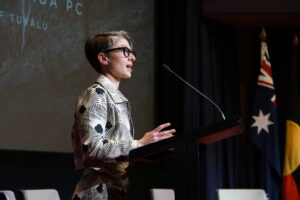A little bit of economic theory is a dangerous thing, and many of the people defending what BHP and Rio Tinto have done to the price of iron ore are demonstrating that they have very little economic knowledge indeed.
Economists usually don’t like cartels, or other forms of producer protections, as they help producers and harm consumers. The stated purpose of free trade agreements and domestic competition policy is to keep prices low for consumers. But why should Australian policy makers be motivated to keep the price of our exports low? Indeed, why would a government that is determined to cut foreign aid seek to help foreign consumers?
Joe Hockey’s budget speech contains a startling illustration of the scale of the problem we have caused for ourselves. According to the treasurer, we now export enough iron ore each year to build the equivalent of a Sydney harbour bridge that reached from Sydney to Perth. And back.
A country only gets to sell its natural resources once. The price we get for them, and the taxes paid by the companies we let mine them, is all we get. In the last ten years the decisions of BHP and Rio Tinto have driven those prices, and taxes, well below the levels that would maximise the benefits for Australia.
Australia has a larger share of the world traded coal market that the Saudis have of the world traded oil market. And Australia has a larger share of the traded iron ore market than all of OPEC’s share of the oil market. If you think that the Saudis are big in oil, then Australia is huge in iron ore.
But while the OPEC countries think that the way to get rich is to restrict supply and keep the price high, Australian politicians would have us believe that doubling our exports and pushing the price down is the smart way to go. One of us is completely wrong, and I suspect it’s not the billionaire sheiks.
While Hockey’s image of the trans-continental bridge worth of annual exports is compelling, it’s the expansion in our exports, not their current level, that tells the real story. Between 2013 and 2014 the quantity of iron ore exports grew by 23 per cent, enough to drive the price down by around 25 per cent. While we sold more iron ore, we got less money. It was only back in 2007 that we were ‘only’ exporting the equivalent of enough iron ore for a one way trip across the Nullarbor.
There are two main explanations for why Rio Tinto and BHP have been so keen to push down the price of our biggest export. The first is that they stuffed up their forecasts of Chinese demand. The second is that this is all part of some cunning plan to drive their competitors, in Australia and internationally, to the wall. Both warrant examination in an inquiry such as that proposed by Senator Nick Xenophon.
According to the ABS, Australia’s mineral and energy resources are worth $1,158 billion, or 13 per cent of the total Australian wealth of $9,125 billion. Put another way, our superannuation is already worth far more than the future profits of our mineral resources.
Australia’s population is smaller than some global cities, but between us we own a continent worth of natural resources. Throughout our history, those resources have made a handful of families very rich, but our collective wealth, and our collective future, never has, and never will, be defined by our mineral wealth. Indeed, the planned doubling of our population will lead to a halving in our personal ‘share’ our mineral wealth.
Australian citizens have inherited a significant, but not enormous, bundle of natural resources. We can sell them off as quickly as we want, but we never get them to sell again. Simple economic analogies about free trade are being used to justify the decision making of BHP and Rio Tinto, but if flooding the market and sinking the price was the best way to get rich then why do Apple make so much money selling such expensive phones, and why have OPEC made so much money selling such expensive oil? A parliamentary inquiry into how Australia’s scarce resources are managed is well overdue.
Related documents
Between the Lines Newsletter
The biggest stories and the best analysis from the team at the Australia Institute, delivered to your inbox every fortnight.
You might also like
The Wellbeing Framework needs a better measure of living standards
The Wellbeing Framework suggests Australia’s prosperity is linked with company profits, but it wrongly suggests this also measures people’s living standards.
The Climate Crisis is an Integrity Crisis | Polly Hemming
I am starting my address to this year’s summit in the exact same way that I started last year’s address. Because it is just over a year since I delivered these same words, which aren’t actually my words. They are the words of our Climate Change Minister, and they provide a baseline of sorts for what progress has been made in that time.
Western Australia’s phony gas shortage
Western Australia produces much more gas than the state needs and any fears of a shortage is driven by the industry to increase prices

